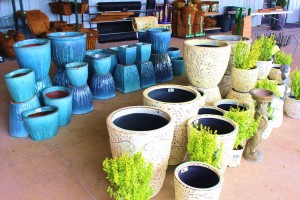 |
CONTAINERS
|
 |
SOIL vs GARDEN DIRTCommercially prepared potting soil is recommended in garden containers. Potting soil contains rich organic material such as peat and composted barks needed for optimal plant growth & flowering. It also contains vermiculite, which helps the soil drain; yet keeps it moist, resulting in healthy roots. Healthy Roots = Healthy Plants! Dirt from the garden should never be used in containers. It contains bacteria, noxious seeds, and other harmful organisms that can effect your newly potted plants. Garden dirt also becomes compacted in containers, resulting in rotting roots, stunted growth and eventually plant death. |
 |
LOCATIONBefore selecting the plants for your containers, consider how they will be used & where they will be placed.
All of these factors need to be considered to when choosing the right plants to fill your pots. Planning ahead results in successful container gardening!
|
 |
PLANTSNext comes the fun part! Picking out plants can be a little overwhelming at first because there are so many to choose from, but if you consider a few things first, you will be successful.
You can create a unified collection of potted plants by planning a themed garden. Use your imagination and you’ll be surprised with the fun & unique designs you may come up with. Group flowers by color or create a tiered look by combining plants that are upright, round or trailing. Keep the tallest plants towards the back or center to create a focal point. Trailing plants should be placed towards the edge to naturally cascade. The round plants should be used to fill in the space between the trailers and uprights. Don’t forget about plants known for their sweet scents or bold foliage. Another idea is to grow an edible garden. Consider creating a fresh salsa garden by planting tomatoes & peppers in a large pot surrounded by smaller pots of cilantro & chives. Herb gardens are also very popular. Place these close to the back step for easy harvest. |
 |
PLANT CARE
|


